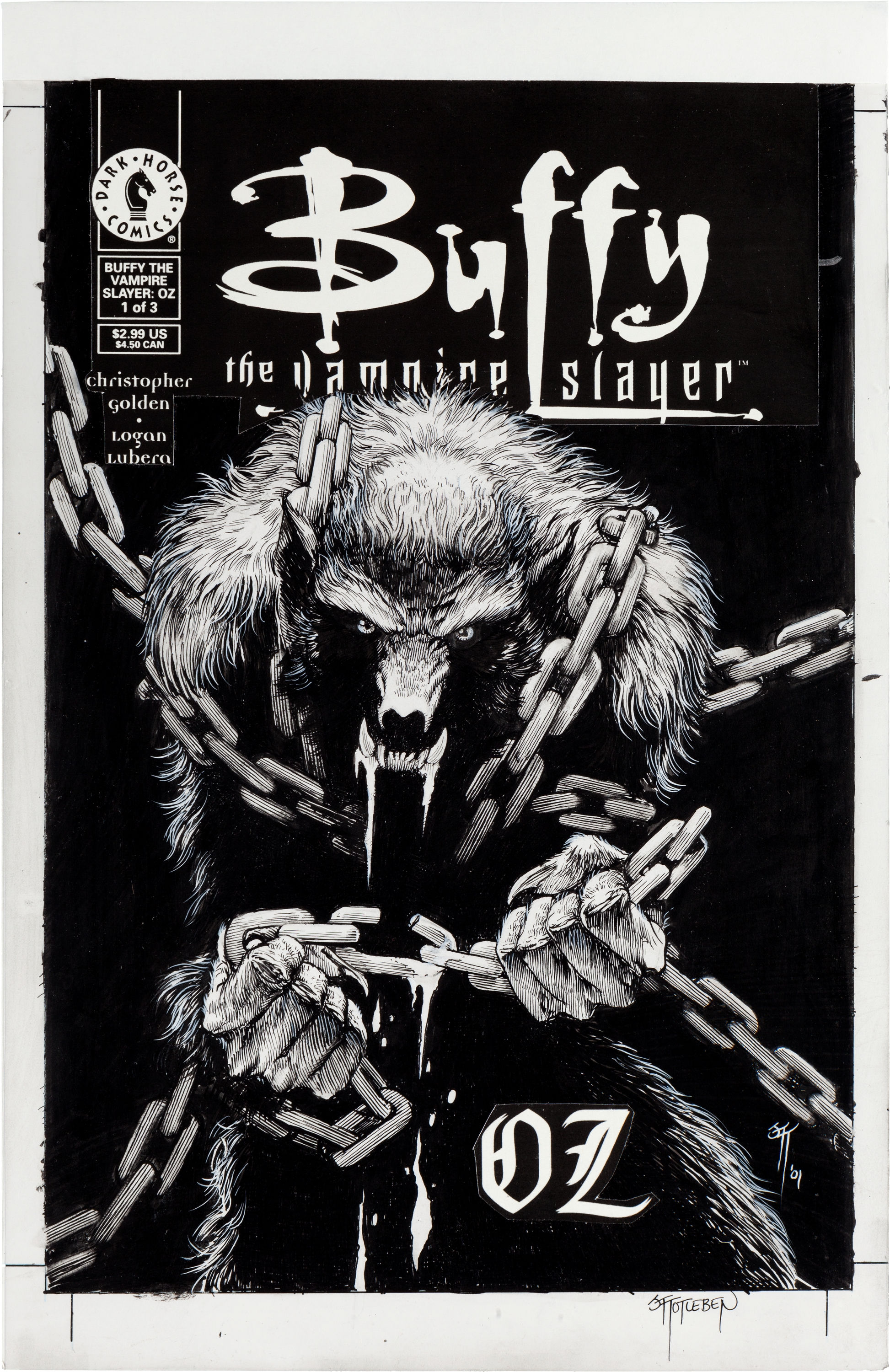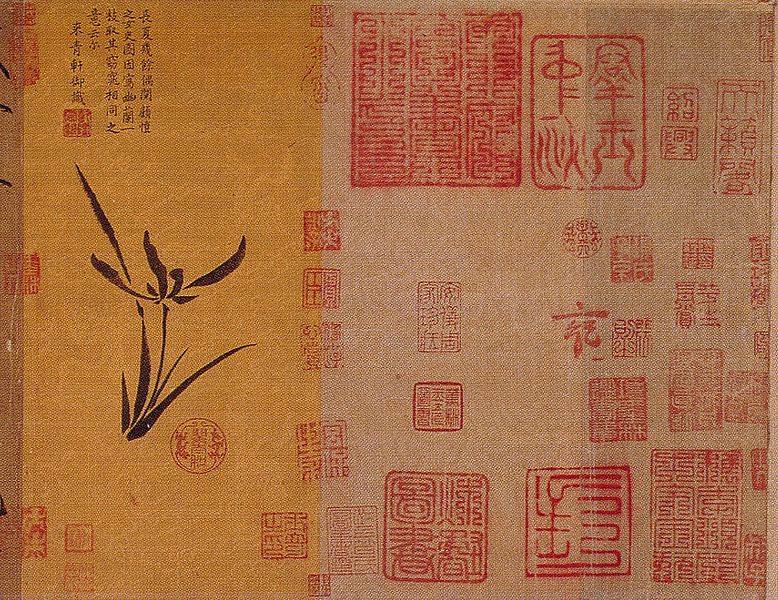A fellow comic art collector sent me a link to an auction for a Buffy the Vampire Slayer cover a few days ago.
Cover to Buffy the Vampire Slayer: Oz #1 (without title overlay)
Autograph covered by title overlay
The drawing is by John Totleben and is, I presume, the image of a transformed Daniel “Oz” Osbourne who is played by Seth Green in the TV series.
Let me first state that I have very little interest in Buffy as a character though I have watched a sizable number (if not all) of the episodes of the TV series. I have never bought a Buffy comic nor do I have any intention of doing so. As for John Totleben, he was certainly one of the most skillful artists to have worked in comics during the 80s and 90s (when his output was at its height). It is clear that he lavishes a considerable amount of time on the projects that are bestowed on him by the movers and shakers of the industry, even those as slight and forgettable as Vermillion.
The first question we should ask of this object is if the autograph which reads “Joss Whedon” is genuine. If it is in fact a fake, all recriminations should fall to the forger.
If we assume the autograph is genuine, I think the best that can be said for this situation is that it is the result of ignorance (or perhaps genius?) on the part of the owner (if the autograph was done to his specifications) or Joss Whedon.
If we assume it was the owner’s choice to have Whedon scrawl his signature in the middle of the art work, one can only conclude that the decision was made on the basis of increasing the value of the art. The signature occupies an area comprising 1/8 of the image area and acts almost like a title in the absence of the acetate overlay. So what would seem like just another werewolf image (in the absence of the overlay) by a skilled but under appreciated comics artist is now brought firmly into the Buffy universe—thus improving its value considerably. Whether the art has been disturbed or even defaced is probably secondary to concerns about monetization. Such is the nature of the business of art in all its forms.
There are important examples of this in art history but few with as detailed a narrative as Chinese brush painting. Those viewing a Chinese painting for the first time might be surprised by the numerous red seals placed discretely or sometimes prominently within the area of the image.
Admonitions Scroll (attributed to Gu Kaizhi, probably a Tang Dynasty copy).
Seals on the Admonition Scroll. Orchid by the Qianlong emperor.
These were often placed by the artists themselves or collectors to denote ownership. As Yang Xin writes in Three Thousand years of Chinese Painting:
“Using seals, however practical, added aesthetic appeal to the paintings, as literati-painters realized. The scarlet stamp could enliven a picture otherwise dull in color, and the choice of seal indicated certain interests and values of the painter, often with subtle cultural, personal , or political implications….A painting is often the joint product of a painter, a poet, a calligrapher, and a seal maker.”
Later in the same book, James Cahill writes:
“…by identifying them [the seals] the knowledgeable viewer can ascertain which collections the painting has passed through. If these are well known and distinguished…the value of the work is correspondingly enhanced….Collectors of good taste kept their seals small and confined their use to the corners; arrogant collectors and emperors impressed large, showy seals in all the available spaces.”
How this applies to the considerably more humble art being discussed here is I think self-explanatory. There is every reason to believe that a tasteful autograph by Joss Whedon (like that placed by Totleben at the right bottom edge of the image; did you miss it?) would increase the value of this Buffy cover. Whether the more florid (almost titular) inscription would have a similar effect is anyone’s guess. I wouldn’t buy the art either way.
If the decision on the placement and size of the autograph was entirely Whedon’s, it might even speak to where he sees himself in relation to these comics interlopers—the artists and writers not only being completely interchangeable (if not irrelevant) but possibly beyond his control. He seems to have little say regarding all future film iterations of his creation as captured in this Guardian article from 2010:
“I always hoped that Buffy would live on even after my death. But, you know, AFTER. I don’t love the idea of my creation in other hands, but I’m also well aware that many more hands than mine went into making that show what it was. And there is no legal grounds for doing anything other than sighing audibly. I can’t wish people who are passionate about my little myth ill.”
This seems like a healthy attitude and no one doubts that this is the reality of working on a Buffy film (or comic; one should note that it appears that Whedon had nothing to do with writing these “Oz” comics beyond the creation of the original concepts).
This image presents itself as an adequate metaphor for the role of the hired hand in the comics business—even outside the remit of the larger comics companies among which Dark Horse (who published the Buffy comics) could certainly be counted. Even in this instance where Totleben did almost all of the work (I suppose a cover concept might have been communicated to him), Whedon’s signature is still five times larger than Totleben’s. Technique and Totleben’s “secondary” imagination (he didn’t create the character) has become superfluous. The idea that Totleben drew this or that it could be a piece of art doesn’t even enter into the equation (or the mind). An online image search suggests that the trade paperback edition dispenses almost entirely with drawn art and chooses to put images of Alyson Hannigan and Seth Green on the cover; the better to sell it one presumes.
Now some might see in this (and many other examples) an occasion for a small fit of pique quickly stifled. One might even interpret that large Whedon scrawl as just that—a moment of pique—because Whedon doesn’t actually own the rights to Buffy (they’re with Warner apparently). And who can begrudge them (and hired hands everywhere) those simple emotions? That quick stifling is probably of the essence—a necessary survival mechanism— for such stratifications and losses are as certain as getting wet in the rain. Parasols don’t seem particularly popular in the land of comics.




Not to take a stance one way or the other, but haven’t comics readers of a certain stripe been insisting on — even fetishizing — the primary status of “original” creators and the originary creative act (over every iteration that comes afterward)?
Hmm, I suppose they have. The situation could be compared to the Before Watchmen situation. Maybe asking Joss Whedon to sign Buffy art could be compared to asking Alan Moore to sign Darwyn Cooke’s original art for Minutemen. Someone like George Lucas wouldn’t mind one way or another since he gives the green light to all these non-canonical iterations.
OR, maybe Whedon thought the art was just like any comic book, and didn’t feel the need to be treat it with any special consideration.
I don’t think “one can only conclude that the decision was made on the basis of increasing the value of the art.” It is only one possibility and not even necessarily the most likely.
I think Peter’s assertion above about the fetishization of Whedon as the “Original Creator” is a lot more likely – and if the owner of the print wants Whedon to sign it, why shouldn’t he? It belongs to the person asking him to sign it.
I don’t understand why this needs any special consideration beyond that.
Weirdly, I saw you say that John Totleben is the “secondary” creator of this artwork conceptually. I don’t take any exception to that except to say, This just looks like any old werewolf….there is nothing “OZ” about it…it could be any werewolf if you took off the type. So I think John actually is the primary creator of this art, because it in no real way refers to the design of Oz in the show( except in the most tangental of viewings…any werewolf could be “oz” in this case). I assume the case could also be made that Whedon, other than just saying, ” I need a werewolf costume for the next show” did nothing for the “design” of Oz.